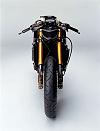| |
|
|
| |
Text from
Kawasaki Heavy Industries LTD ZX10R Technical information |
|
| |
Ultimate Supersport! Kawasaki storms into the
litre-class with the uncompromising new Ninja ZX-10R, the machine
everyone has been waiting for - everyone except the competition.
Unlike most other Kawasaki machines, the ZX-10R design started with
chassis simulations. The goal was a extremely lightweight and compact
chassis that would offer superb handling and stability.
The engine is bolted into all-aluminium twin-tube
backbone frame that arches over the engine rather than around it, as
with conventional sportbike designs. Constructed of thin-walled castings
and pressed aluminium sheets welded together for optimum lightness, the
ZX-10R frame provides exceptional high-speed stability and responsive
handling, yet is no wider than most 600cc-class sportbikes. (picture
1-3 right, 10-11 below)
Actually more compact than the ZX-6R frame |
|
| |
 |
 |
 |
|
| |
10. |
11. |
12. |
|
| |
Kawasaki engineers utilized a "stack" design for the extraordinarily
compact, liquid-cooled, 998cc inline four-cylinder engine. The crank
axis, input shaft and output shaft of the engine are positioned in a
triangular layout to reduce engine length, while the high-speed
generator is placed behind the cylinder bank to reduce engine width.
With a bore and stroke of 76 x 55mm, the ZX-10R engine's one-piece
cylinder and crankcase assembly reduces weight and increases rigidity.
(picture 6-9 right)
Key features:
-
Lightweight Forge Pistons,
Spark Plug-Mounted
Ignition Coils
-
Digital Timing Advance,
EFI with 43mm Keihin Throttle
Bodies
-
Central Ram Air Induction
System,
Titanium Exhaust with
Butterfly Valve
-
High-speed processor provides precise
engine management
|
|
| |
 |
 |
|
| |
13. |
14. |
|
| |
Stopping
power for the ZX-10R is provided by dual 300mm front disc brakes
featuring petal disc design, radially mounted four-piston callipers, and
a single 220mm rear disc brake. The radial front brake design utilizes
mounting points at both the top and bottom of the calliper, with the
mounting bolts inserted through the rear of the calliper instead of the
side or front as on conventional designs. This racing-inspired setup
makes the calliper more rigid to improve brake feel over a wider range
of operation. (picture
4, 5 right)
Key features:
-
Individual brake pads for each piston
prevent pad deformation due to heat
-
Petal Design brake discs improve
cooling and warp resistance
-
First "wavy" type discs to come
standard on a Supersport machine
|
|
| |
 |
 |
 |
|
| |
15. |
16. |
17. |
|
| |
With
the help of a front area smaller than that of a NINJA ZX-6R, the
angular body work and racing-style ergonomics of the ZX-10R
minimizes aerodynamic drag on the race track. A central ram air duct
incorporated into the nose of the fairing provides cool, dense air
to the airbox, which is situated between the frame tubes. The top
portion of the fuel tank is also concave, so the competition rider
can tuck in tightly behind the small windscreen.
(picture
12-14 above)
Other features include multi-reflector headlights, forged aluminium
handlebars that are gun-drilled to reduce weight. LCD display with
radial tachometer and digital speedometer, plus a stop watch
function and LED tail light.
-
Advanced Electronic
Instrumentation (picture
15-17 above)
-
All-LCD display features digital
step motor speedometer and temperature gauge inside the bar
display tachometer
-
Multi-function odometer, trip
meter, clock and lap timer/stopwatch
|
|
| |
|
|
|
|
| |
 |
|
New frame
makes the ZX10 no bigger than most 600cc |
|
|
| |
1. |
|
| |
 |
|
Frame runs over the
engine to give keep the bike compact. |
|
|
| |
2. |
|
| |
 |
|
Massive braced swing
arm delivers the rigidty needed. |
|
|
| |
3. |
|
| |
 |
|
New design, the most
spectacular Kawasaki for years. |
|
|
| |
4. |
|
| |
 |
|
New design, the most
spectacular Kawasaki for years. |
|
|
| |
5. |
|
| |
 |
|
Brand new compact and
powerful engine |
|
|
| |
6. |
|
| |
 |
|
Electronic Fuel Injection and
digital engine management |
|
|
| |
7. |
|
| |
 |
|
New design, the most
spectacular Kawasaki for years. |
|
|
| |
8. |
|
| |
 |
|
Generator behind the cylinder
to reduce engine width. |
|
|
| |
9. |
|
| |
 |
|
A look inside the engine. |
|
|
|
|

